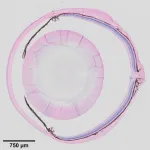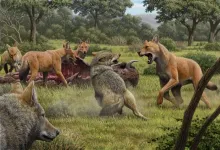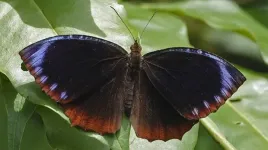(Press-News.org) KANSAS CITY, MO--What if the degenerative eye conditions that lead to glaucoma, corneal dystrophy, and cataracts could be detected and treated before vision is impaired? Recent findings from the lab of Investigator Ting Xie, PhD, at the Stowers Institute for Medical Research point to the ciliary body as a key to unlocking this possibility.
Previous work from the lab showed that when mouse stem cells were differentiated into light-sensing photoreceptor cells in vitro, and then transplanted back into mice with a degenerative condition of the retina, they could partially restore vision. However, the transplanted photoreceptors only lasted three to four months.
"You cannot cure the condition in a diseased eye if you don't know what causes the disease," says Xie. "This has been a major hurdle for stem cell therapy in treating degenerative diseases."
To this end, Xie's group began to study the eye tissue microenvironment, specifically a specialized tissue in the eye called the ciliary body. Located at the posterior edge of the iris, it is known to maintain ocular pressure by secreting aqueous humor, the clear fluid between the lens and the cornea. It has a similar function in mice and in humans, and defects in the ciliary body manifest in similar ways in the mouse and human eye.
"People think the ciliary body is boring," says Xie. This might be because the ciliary body was once thought to have a reserve of retinal stem cells, Xie explains, which turned out not to be true. However, its role in eye biology turns out to be quite broad, and "without a functioning ciliary body, the eye degenerates," Xie adds.
When the Notch signaling pathway--an important cell signaling system found across the animal kingdom--is defective in the ciliary bodies of newly born mice, they fail to develop folds, and secretions decrease, leading to shrunken vitreous bodies. In adult mice, defects in Notch signaling cause low eye pressure, a shrunken vitreous, and eye degeneration. Inactivation of the downstream transcription factor RBPJ in the ciliary body also leads to the same effects. Before now, the underlying molecular mechanism for this outcome was unclear.
In a paper published in Cell Reports on January 12, 2021, first author Ji Pang, a visiting PhD student from Shanghai Jiao Tong University, China, and others describe a signaling pathway wherein Notch and Nectin proteins in the ciliary body function in the development and maintenance of eye tissue and structure.
In this report, the researchers describe the roles of adhesion protein Nectin1 and gap junction protein Connexin43 in the ciliary body of mice. They found that Notch2/3-Rbpj signaling in the outer ciliary epithelium controls the expression of Nectin1, which works with Nectin3 in the inner ciliary epithelium to keep the two tissue layers together, which promotes proper folding of the ciliary body. They found that Notch signaling also maintains the expression of Connexin43 in the outer ciliary epithelium, while Nectin1 localizes and stabilizes Connexin43 on the lateral surface, which maintains the vitreous body and intraocular pressure.
Lastly, the researchers found that in addition to maintaining ocular pressure and directing ciliary body morphogenesis, Notch2/3-Rbpj signaling in the inner ciliary epithelium also regulates the secretion of various proteins such as Opticin and collagens into the vitreous body, providing nutritive support for the cornea, the lens, and the retina.
"We propose the ciliary body could be a niche for the eye tissues," explains Xie, in the sense that it can behave like a stem cell niche, by providing signals that affect cellular morphogenesis and function. "The next important question is what other protein factors secreted by the ciliary body are important for maintaining the cornea, the lens, and the retina, respectively. Some of these factors could be involved directly in eye diseases."
INFORMATION:
Other coauthors of the study included Liang Le, PhD, Yi Zhou, PhD, Renjun Tu, PhD, Qiang Hou, PhD, Dai Tsuchiya, PhD, Nancy Thomas, Yongfu Wang, PhD, Zulin Yu, PhD, Richard Alexander, Marina Thexton, Brandy Lewis, Timothy Corbin, Michael Durnin, and Hua Li, PhD, from Stowers; Ruth Ashery-Padan, PhD, from Tel Aviv University, Israel; and Deyue Yan, PhD, from Shanghai Jiao Tong University, China.
This work was supported by the Stowers Institute for Medical Research, the National Eye Institute of the National Institutes of Health (award R01EY027441 to TX), and a China National Scholarship (JP). The content is solely the responsibility of the authors and does not necessarily represent the official views of the National Institutes of Health.
Lay Summary of Findings
One of the leading causes of glaucoma is high intraocular pressure, which can cause blindness due to damage of the optic nerve. Intraocular pressure is largely maintained by the ciliary body, a specialized tissue in the eye of animals that secretes fluids. It also functions to maintain structural integrity of the eye, but detailed mechanisms of how it does so had not yet been described.
In a study published online January 12, 2021, in Cell Reports, researchers at the Stowers Institute for Medical Research from the laboratory of Ting Xie, PhD, and collaborators describe how the Notch pathway regulates the secretion of proteins important for supporting eye structure, and also controls the expression of adhesion proteins Nectin1 and Nectin3 to promote the normal structural development of the ciliary body. They find that Nectin proteins ensure expression of the gap junction protein Connexin43, which functions to ensure proper fluid secretion. This work highlights the broad role of the ciliary body in maintenance of eye health and implicates the ciliary body in various eye diseases.
About the Stowers Institute for Medical Research
The Stowers Institute for Medical Research is a non-profit, basic biomedical research organization dedicated to basic research - the critical first step in the quest for new medical diagnostics, therapies and treatments. Jim Stowers, founder of American Century Investments, and his wife, Virginia, opened the Institute in 2000. Since then, the Institute has spent over one billion dollars in pursuit of its mission.
Currently, the Institute is home to about 500 researchers and support personnel, over 20 independent research programs, and more than a dozen technology development and core facilities. Learn more about the Institute at http://www.stowers.org and about its graduate program at http://www.stowers.org/gradschool.
Scientists in China and Sweden have determined that a pinch of capsaicin, the chemical compound that gives chili peppers their spicy sting, may be a secret ingredient for more stable and efficient perovskite solar cells. The research, published January 13 in the journal Joule, determined that sprinkling capsaicin into the precursor of methylammonium lead triiodide (MAPbI3) perovskite during the manufacturing process led to a greater abundance of electrons (instead of empty placeholders) to conduct current at the semiconductor's surface. The addition resulted in polycrystalline MAPbI3 solar cells with the most efficient charge transport to date.
"In the future, green and sustainable forest-based biomaterial ...
NEW YORK, January 13, 2021 -- Many animal and insect species use Batesian mimicry -- mimicking a poisonous species -- as a defense against predators. The common palmfly Elymnias hypermnestra -- a species of satyrine butterfly that is found throughout wide areas of tropical and subtropical Asia -- adds a twist to this evolutionary strategy. The females evolved two distinct forms, either orange or dark brown, imitating two separate poisonous model species, Danaus or Euploea. The males are uniformly brown. A population group is either entirely brown (both males and females) or mixed (brown males and orange females).
David Lohman, ...
The iconic, prehistoric dire wolf, which prowled through Los Angeles and elsewhere in the Americas over 11 millennia ago, was a distinct species from the slightly smaller gray wolf, an international team of scientists reports today in the journal Nature.
The study, which puts to bed a mystery that biologists have pondered for more than 100 years, was led by researchers from UCLA, along with colleagues from Durham University in the U.K., Australia's Adelaide University and Germany's Ludwig Maximilian University.
"The terrifying dire wolf, a legendary symbol of Los Angeles and the La Brea Tar Pits, has earned its place among the many large, unique species that went extinct at the end of the Pleistocene ...
Mutations that occur in certain DNA regions, called tandem repeats, may play a significant role in autism spectrum disorders, according to research led by Melissa Gymrek, assistant professor in the UC San Diego Department of Computer Science and Engineering and School of Medicine. The study, which was published in Nature on Jan. 14, was co-authored by UCLA professor of human genetics Kirk Lohmueller and highlights the contributions these understudied mutations can make to disease.
"Few researchers really study these repetitive regions because they're generally non-coding--they do not make proteins; their function is ...
Extinct dire wolves split off from other wolves nearly six million years ago and were only a distant relative of today's wolves, according to new research published in Nature today (13 January).
Dire wolves, made famous in the TV show Game of Thrones, were common across North America until around 13,000 years ago, after which they went extinct.
The study shows that dire wolves were so different from other canine species like coyotes and grey wolves that they were not able to breed with each other. Previous analyses, based on morphology alone, had led scientists to believe that dire wolves were closely related to grey wolves.
The research was led by Durham University in the UK alongside scientists at the University of Oxford, Ludwig Maximilian University in ...
New York, NY--January 13, 2021--Researchers at Columbia Engineering report today that they have developed the first nanomaterial that demonstrates "photon avalanching," a process that is unrivaled in its combination of extreme nonlinear optical behavior and efficiency. The realization of photon avalanching in nanoparticle form opens up a host of sought-after applications, from real-time super-resolution optical microscopy, precise temperature and environmental sensing, and infrared light detection, to optical analog-to-digital conversion and quantum sensing.
"Nobody has seen avalanching behavior like this in nanomaterials before," said James Schuck, associate professor of mechanical engineering, who led the study published today by Nature. "We ...
Even computers can miscalculate. Already small disturbances change stored information and corrupt results. That is why computers use methods to continuously correct such errors. In quantum computers, the vulnerability to errors can be reduced by storing quantum information in more than a single quantum particle. These logical quantum bits are less sensitive to errors. In recent years, theorists have developed many different error correction codes and optimized them for different tasks. "The most promising codes in quantum error correction are those defined on a two-dimensional lattice," ...
A new study by researchers at the University of Chicago and the City College of New York (CCNY) has identified a unique, genetic "mimicry switch" that determines whether or not male and female Elymnias hypermnestra palmflies mimic the same or different species of butterflies. The results indicate that sexual dimorphism has repeatedly emerged in different palmfly populations, and linked the trait to a gene associated with melanin localization and regulation.
Published on Jan. 13 in the journal END ...
Red and green algae that grow on snow in the Antarctic Peninsula (AP) cause significant extra snowmelt on par with melt from dust on snow in the Rocky Mountains, according to a first-of-its-kind scientific research study led by Alia Khan, affiliate research scientist at the National Snow and Ice Data Center (NSIDC) and assistant professor at Western Washington University. Algal blooms are likely to increase in Antarctica as the planet continues to warm, which will further exacerbate seasonal snowmelt and contribute to the expansion of ice-free areas in the AP region. This could have serious impacts on regional climate, snow and ice melt, freshwater availability and ecosystems, yet is not accounted for in current global climate models. Results of the research were published on ...
Scientists claim to have found the 'missing link' in the process that leads to an ice age on Earth.
Melting icebergs in the Antarctic are the key, say the team from Cardiff University, triggering a series of chain reactions that plunges Earth into a prolonged period of cold temperatures.
The findings have been published today in Nature from an international consortium of scientists from universities around the world.
It has long been known that ice age cycles are paced by periodic changes to Earth's orbit of the sun, which subsequently changes the amount of solar radiation that reaches the Earth's surface.
However, ...






